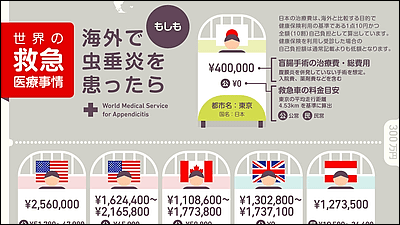One in 28 people encounters an accident, the tendency of overseas travel trouble seen in insurance statistics and measures

36 people in 1000 people, about 3.6% of overseas travelers are getting involved in some troubles at the traveling destination and JICF Insurance Co., Ltd.Releasedoing. Also, the travel information reviews site "trip advisorBased on the above data, we summarize the contents of the accident in an easy-to-understand infograph, so let's check the trends and measures of the trouble.
Overseas travel trouble trends Visible to the world with info graphics
http://tg.tripadvisor.jp/accident/
The figure below shows a figure showing how many people are involved in troubles requiring insurance as if 1,000 people were traveling abroad. A person drawn in dark red, pink, gray indicates a traveler involved in some kind of accident. As an impression that I looked at, I felt that it occurred at a rate of about 1 person per class as compared to a school.
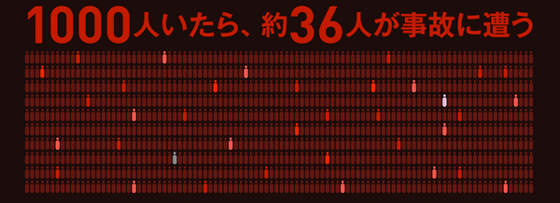
So, what kind of use did the people who actually had trouble use insurance? The figure below shows the breakdown. The most common is "treatment / relief expenses", almost half of whom fall under this case. The next most popularity is "handy goods damage" about one-third, afterwards "travel accident emergency expense" and so on.

"The treatment / relief expenses" which was most used in the insurance are the money paid by going to the hospital because it became injured or sick at the travel destination, or when you ask your family and friends to come home to come home because of your own difficulties It is about expenses etc. In overseas there are also risks of illness such as dengue fever, yellow fever, malaria etc which are not initially common in Japan such as abdominal pain and influenza, appendicitis such as appendicitis (so-called cecum) and so on domestically, so use of insurance is many in this category It seems to be getting.
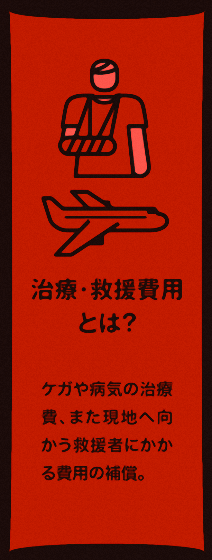
"Handling goods damage" is a case where insurance was applied for the theft or damage of luggage such as bags, cameras, PCs and the like. Insurance applied for not only accidents such as broken suitcase deposited on an airplane or the like but also damage such as withdrawal or snatching are included here.
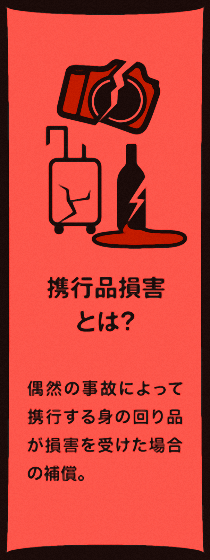
"Travel accident emergency expense" is a transportation expenses forced to pay due to an unexpected accidental accident, such as a case where the reserved airplane was canceled or delayed, or when the baggage leaving the airline did not reach the site , Accommodation expenses, meals, etc.
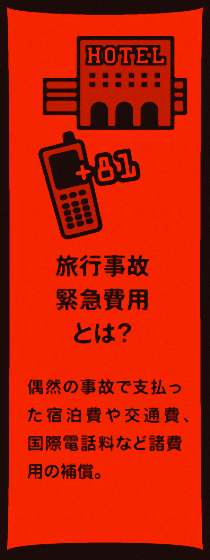
"Compensation liability" is compensation of expenses in case of damaging others or things in the accident, but the proportion occupied in the whole is as low as about 1.5%.
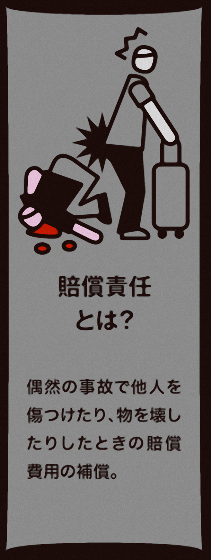
"Travel change cost" is to compensate for transportation expenses for canceling travel on the way due to unavoidable reasons and the penalty fee incurred when canceling departure. It is a very rare case of 0.6% in FY 2011, but it seems that the number of applications has increased more than usual in FY 2010, as there were large cold waves in Europe and demonstrations in Bangkok.
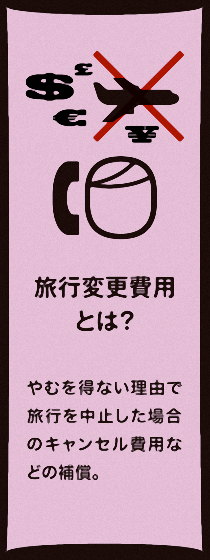
So, where and what kind of accident actually happens? The data is as follows. It seems that there is a tendency to be encountered depending on the area, so checking it before going on a trip seems to be a reference for avoiding the accident.
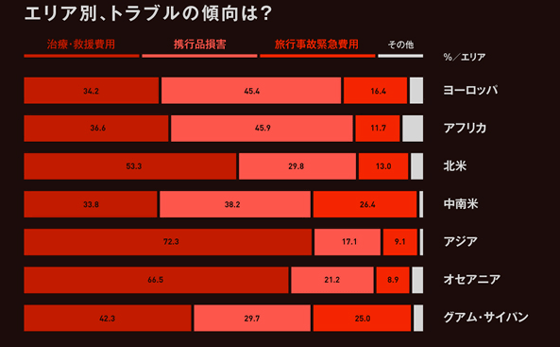
In Europe, "trouble of carrying goods" is the trouble with the highest occurrence ratio, depending on the destination, the number of transit of airplanes increases and the number of load transfers increases, so it is easy for damage to suitcases to occur. Moreover, it seems that there are many damages caused by pickpockets regarding damage caused by theft.

In Africa, too, the proportion of "carry-on goods damage" which accounts for the total trouble is the highest, and the breakdown is unknown, but it is estimated that there are a lot of damage by robbery, pickpocket and the like in general because there are many unfavorable areas from Japan I will.

In North America, "treatment and relief expenditure" accounts for the highest proportion, "proportion of carried item" is lower than Europe by 15% or more.

In Central and South America, the percentage of "accident emergency expenses for travel accident" to be noteworthy is as high as 26.4%. Since it is the highest value in all areas, it seems necessary to set up measures especially for flight cancellation, delay, lost baggage etc. when using an airplane.

In Asia, the sanitation environment is relatively bad and the climate is often different from Japan, so it is easy to lose physical condition, so "treatment / relief expenses" is the highest among all areas as 72.3%. If it is a mild headache or diarrhea, it is often possible to improve symptoms with marketing medications, so it is recommended that you take medicine you use every day from Japan. However, even if it seems to be a simple abdominal pain, there are cases of dangerous diseases, so let's go to the hospital immediately if you do not recover even if you look at it for a while.

As in Asia, Oceania has a higher ratio of "treatment / relief expenses". Especially the reason is not disclosed, but this is because the number of occurrences of other troubles such as cargo breakage, theft, airplane delay etc. is small, so the proportion of "treatment / relief expenses" is relatively high I think that it is not.

In Guam and Saipan, the delay of flights due to the influence of weather conditions such as typhoons and the absence of flights are many, so the proportion of "accident emergency travel expenses" is very high compared with other areas. When going to this area, it is good to have a schedule and schedule a schedule that can be avoided without sudden flight cancellation.

Please note that the above infographs do not include uninsured travelers in the data as they indicate the percentage of people who have insured themselves accidentally accidentally. Therefore, in fact, the percentage of travelers who are involved in trouble abroad may be higher. By the way, even if you get involved in insurance you can basically avoid monetary damages, but with insurance all the costs will be borne by yourself so be careful.If you perform an operation of appendicitis (cecitis) in Los Angeles it costs more than 2 million yenBecause there seems to be a case called overseas, when going abroad it is safe to take measures to securely set up measures based on the tendency of problems that are likely to occur in travel destinations after joining insurance.
Related Posts:
in Note, Posted by darkhorse_log

